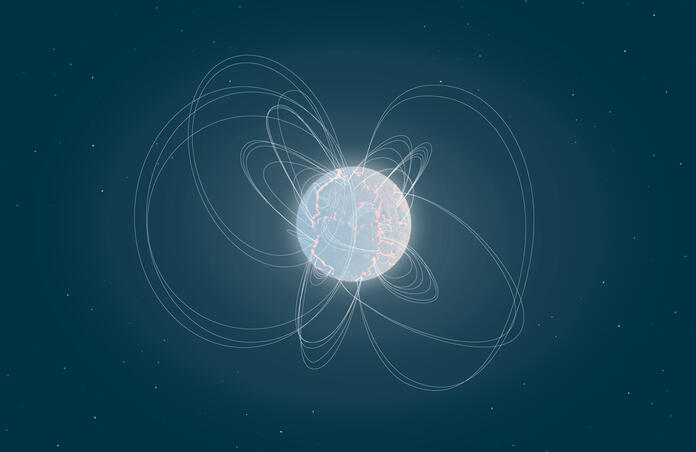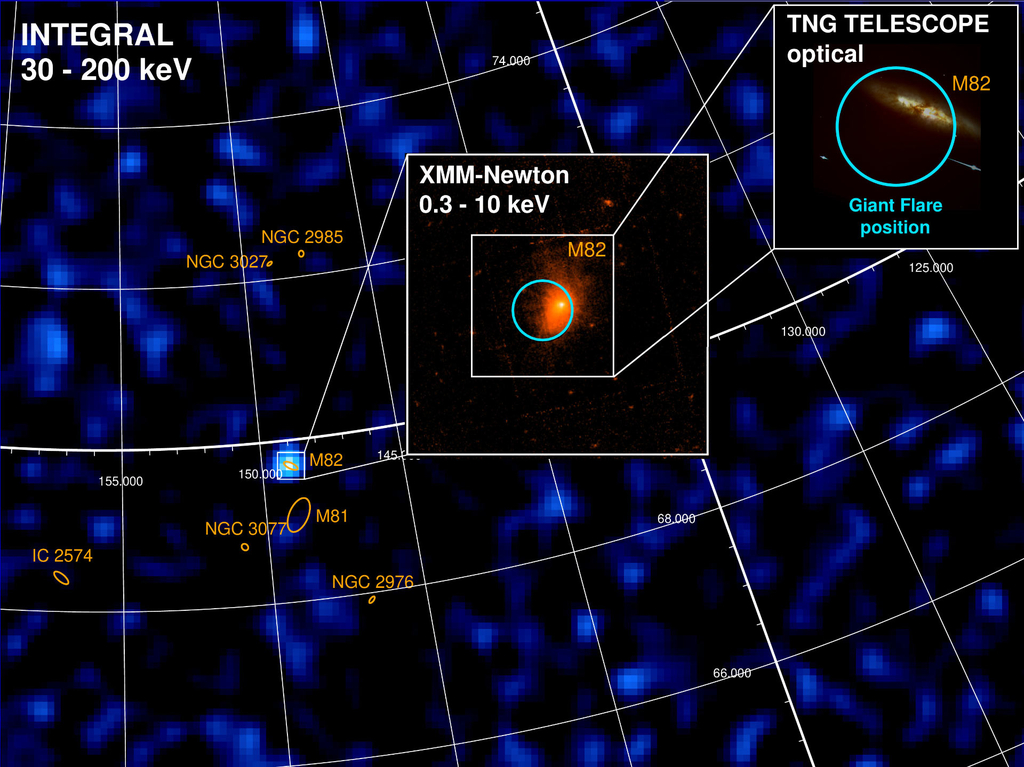Giant magnetar flare detected from nearby galaxy

A burst of gamma rays has been detected coming from the nearby galaxy M82 by ESA’s satellite INTEGRAL. Due to the lack of afterglow when it was later observed by ESA’s XMM-Newton X-ray telescope, an international team of astronomers have proposed that this must be an extra-galactic flare from a magnetar, making it the first detection of its kind outside our galaxy.

The satellite observed the sudden burst on the 15th of November 2023, where the burst of gamma rays were visible for just a tenth of a second. The flare was named GRB 231115A. "The satellite data were received in the INTEGRAL Science Data Center (ISDC), based on the Ecogia site of the UNIGE Astronomy Department, from where a gamma-ray burst alert was sent out to astronomers worldwide, only 13 seconds after its detection," explains Carlo Ferrigno, senior research associate in the Astronomy Department at UNIGE Faculty of Science, PI of the ISDC and co-author of the publication.
With the help of the Integral Burst Alert System (IBAS) software, an automatic localisation coinciding with the galaxy M82 was made. M82 is a starburst galaxy located 12 million light years away from us. The alert system was set up and operated by scientists and engineers from UNIGE in collaboration with international colleagues.
"We immediately realized that this was a special alert. Gamma-ray bursts come from far-away and anywhere in the sky, but this burst came from a bright nearby galaxy," explains Sandro Mereghetti of the National Institute for Astrophysics (INAF–IASF) in Milan, Italy, lead author of the publication and contributor of IBAS.
The team immediately requested follow-up observations to be taken by ESA’s XMM-Newton space telescope as soon as possible. If this was a short gamma ray burst caused by the result of two neutron stars colliding, gravitational waves would’ve been created leading to an afterglow in X-ray and visible wavelengths. However, the XMM-Newton observations showed only hot gas and stars in the galaxy. A signal in the visible was searched for by ground-based optical telescopes a few hours after the explosion, including the Italian Telescopio Nazionale Galileo and the French Observatoire de Haute-Provence, but nothing was found.
From the lack of detections in the X-ray and visible, in addition to no gravitational waves being measured by detectors on earth such as LIGO, the most probable explanation for the burst is a magnetar. "When stars more massive than eight times the sun die, they explode in a supernova that leaves a black hole or neutron star behind. Neutron stars are very compact stellar remnants with more than the mass of the sun packed into a sphere with the size of the Canton of Geneva. They rotate quickly and have strong magnetic fields," explains Volodymyr Savchenko, senior research associate in the Astronomy Department at UNIGE Faculty of Science, and co-author of the publication.
Magnetars are young neutron stars which have particularly strong magnetic fields, being over 10,000x that of typical neutron stars. Such stars emit energy in flares, and on occasion these flares are enormous. However, flares of this size are also rare; in the past 50 years of gamma ray observations, only 3 giant flares have been identified as originating from magnetars within the milky way. These outbursts were extremely strong. One detected in December 2004 was situated 30,000 light years away but still possessed enough power to affect the upper layers of Earths atmosphere, much like solar flares, which originate much closer.
The INTEGRAL detected flare is the first firm confirmation of a magnetar flare outside of our galaxy. M82 is a starburst galaxy, birthing massive stars who live short violent lives, leaving behind a neutron star. "The discovery of a magnetar in this region confirms that magnetars are likely young neutron stars," adds Savchenko.
Astronomers will continue the search for more magnetars in extra-galactic star forming regions to better understand these peculiar objects. If more are found, they can uncover how often these flares occur and how neutron stars lose energy in the process. Outbursts of such short duration can only be spotted if an observatory is already pointing in the correct direction. This makes INTEGRAL vital for such detections, due to its vast field of view being over 3000x larger than the sky area covered by the moon.
Ferrigno explains, "Our automatic data processing system is highly reliable and enables us to alert the community immediately." When unexpected observations like this are picked up, INTEGRAL and XMM-Newton can be flexible in their schedules, which is essential in time-crucial discoveries.
--
Journal source: A magnetar giant flare in the nearby starburst galaxy M82, Nature (2024). DOI: 10.1038/s41586-024-07285-4
